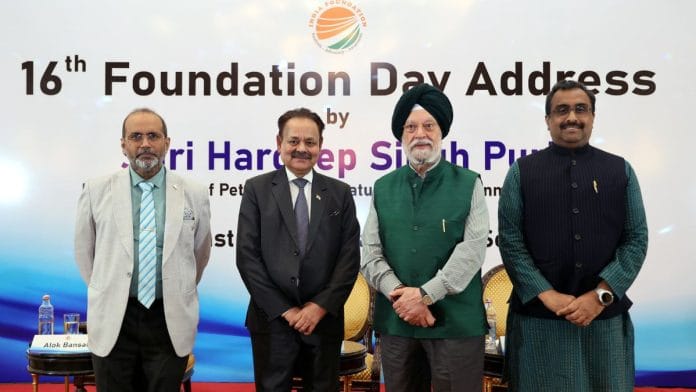New Delhi: India is well prepared to weather the closure of the Strait of Hormuz or disruption to the flow of oil from West Asia, said Hardeep Singh Puri, the Minister of Petroleum and Natural Gas Wednesday. The Union Minister downplayed any fears of price spikes, given that there is enough supply of crude oil globally today.
“Roughly 24 percent of global energy passes through the Strait of Hormuz. We [India] consumes around 5.6 million barrels of crude oil per day…Out of this, around 1.5 million barrels to 2 million barrels of oil to India comes from the Strait of Hormuz,” Puri said, while speaking at the sixteenth foundation day of the think-tank India Foundation, at the Leela.
The minister added, “India is now a major exporter and producer of oil. It has a strategic reserve of about 77 days. Oil companies themselves hold reserves of crude oil.”
In the 2023-2024 financial year, India exported $83.4 billion worth of petroleum products, which is one of its largest exports to the global markets, according to the Ministry of Commerce and Industry. In the 2024-2025 financial year, exports of petroleum products fell by around 25 percent to about $62.5 billion.
The 12-day conflict between Israel and Iran raised fears that Tehran would attempt to close the choke point in global energy trade—the Strait of Hormuz. The Iranian Parliament even voted on a resolution calling for the closure of the Strait, however, the Supreme National Council did not take any decision on the resolution before both countries agreed to a ceasefire.
The closure of the Strait is one of the scenarios policy planners have been dealing with for nearly five decades, Puri pointed out. However, despite the consistent what-ifs, the Strait has never been closed. The closest it came was during the Iran-Iraq war in the 1980s. The two countries attacked at least 451 ships by 1987, in an attempt to economically hurt the other.
“Even if Hormuz closes, we are adequately prepared” asserted Puri. The Union Minister added a closure of the Strait would likely not last for an extremely long time, and in the event that it does, there are enough “alternative suppliers” in the market.
Also read: Crude oil prices to freight rates: How Iran’s chokehold on Strait of Hormuz impacts India
India’s refining capacity to grow
India is currently the “fourth largest” refiner of crude oil in the world, with a goal to only grow and double the current capacity as early as possible, Puri noted.
“We have in place 270million metric tonnes per annum to refine. Can take it up to 310 million metric tonnes per annum…The Prime Minister has set a further target of expanding the capacity to 400 million metric tonnes as soon as possible,” said Puri.
“India could become a regional hub for refining,” Puri pointed out, while explaining that in future, there will likely be major consolidation of refineries depending on how the global situation evolves. Furthermore, with India’s current growth trajectory, its energy needs are set to largely increase.
Puri noted that in the next two decades, roughly 25 percent of the increase in global demand for energy is set to come from India. The economy of the country is set to continue its growth trajectory of roughly 6.5 percent a year, which adds to its overall energy consumption.
However, currently there is no fear that there will be a shortage of supply of crude oil to India in particular, despite its growing need.
“Prices will not rise even if the Strait of Hormuz is closed because today there is more oil available in the world than ever before…Even with continuing tensions I don’t see prices shooting up,” said Puri. He further added that there is more oil available today from the Western Hemisphere than previously.
Roughly $14 billion worth of energy goods was purchased from the US the last financial year by India, plus the availability of oil from Guyana, for example, all offer India a certain energy security. Puri, highlighted that the exploration and production of oil and natural gas in India has the potential to grow considerably.
“My oft repeated, yet to be challenged assertion is that there are many Guyanas to be found,” said Puri.
(Edited by Zinnia Ray Chaudhuri)
Also Read: Why Fordow, Natanz & Isfahan facilities struck by US are critical to Iran’s nuclear ambitions






